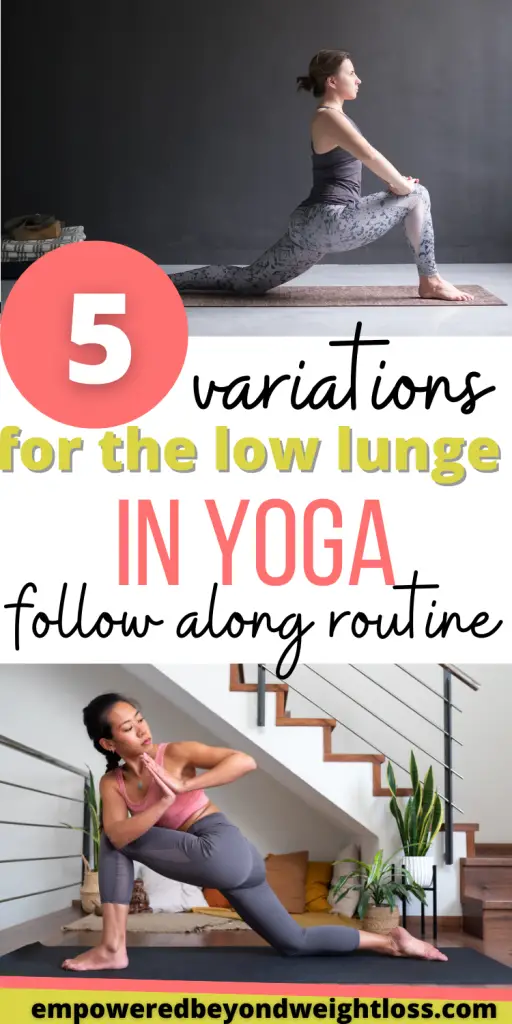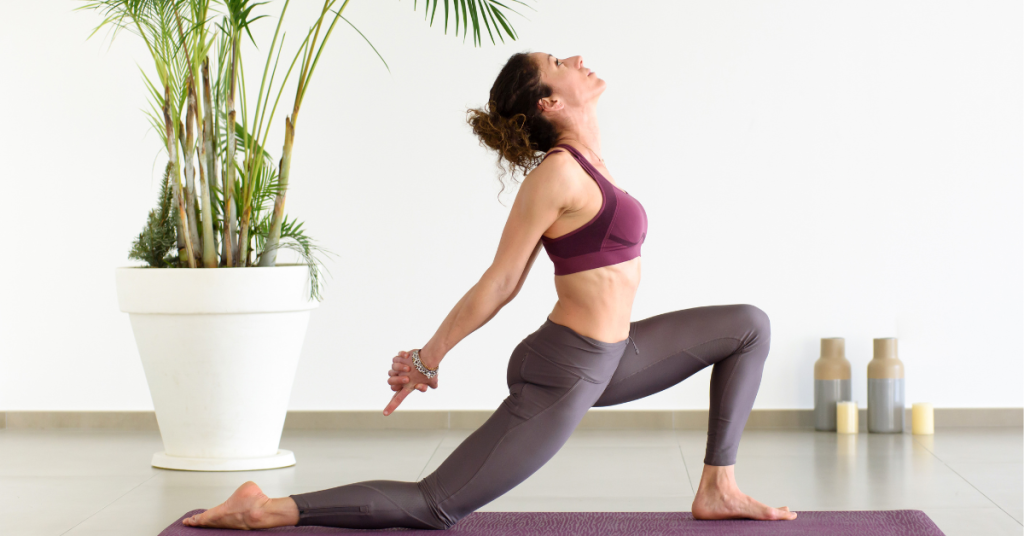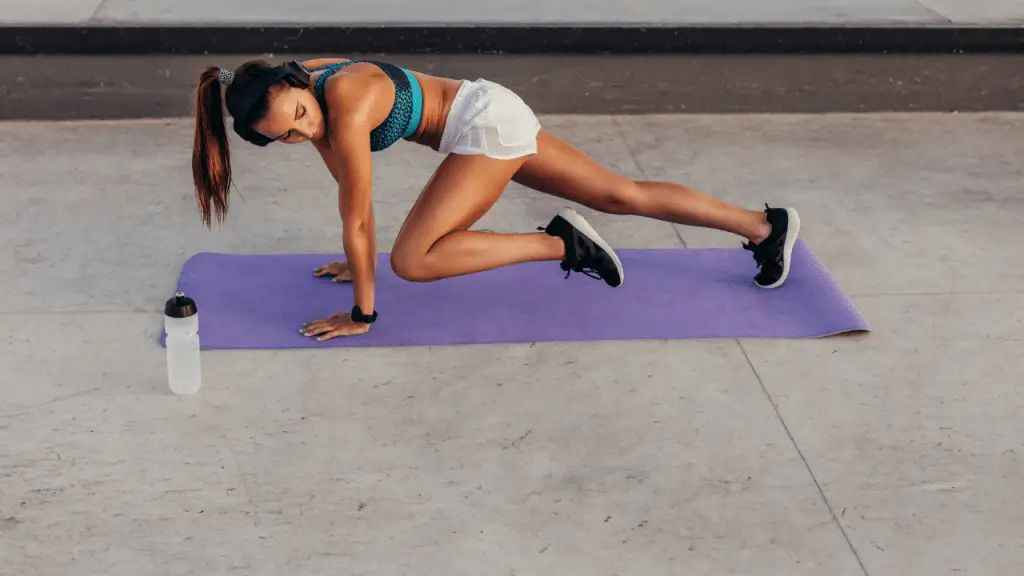The low lunge yoga variations I will share today are perfect for strength and flexibility. There are many active variations and some passive ones that I enjoy practicing. Follow along with me!
How to Do Low Crescent Lunge Pose (Anjaneyasana)
The low crescent lunge, also known as Anjaneyasana, is a yoga pose that stretches and strengthens the legs, hips, and thighs while also opening up the chest and shoulders. Here’s how you can perform the low crescent lunge:
- Starting Position:
- Begin in a standing position, with your feet hip-width apart and your arms at your sides (Mountain Pose or Tadasana).
- Step Back:
- Take a big step back with your right foot. Your feet should be about hip-width apart, with your left foot in front and your right foot behind you.
- Bend Your Front Knee:
- Slowly bend your left knee as you shift your weight onto your left foot. Keep your knee aligned over your ankle, ensuring it doesn’t go past your toes. Your left thigh should be parallel to the floor or as close to parallel as is comfortable.
- Drop Your Back Knee:
- Lower your right knee gently to the floor. You may want to use a blanket or yoga mat for padding under your knee if it’s uncomfortable.
- Toes Pointed Back:
- The top of your right foot should be resting on the floor, and your toes should point directly behind you.
- Engage Your Core:
- Engage your core muscles to support your lower back and maintain balance.
- Hips Square:
- Try to square your hips to the front of your mat by gently pulling your right hip forward and your left hip back. This helps you get a deeper stretch in your hip flexors.
- Arms and Torso:
- Inhale and lift your chest, drawing your shoulder blades down and back.
- As you exhale, raise your arms overhead, with your biceps near your ears. Your palms can face each other or press together in a prayer position (Anjali Mudra).
- Head Position:
- Keep your gaze forward or slightly upward, but be mindful not to compress your neck.
- Hold the Pose:
- Hold the low crescent lunge for 30 seconds to 1 minute, or longer if comfortable.
- Release the Pose:
- To come out of the pose, lower your arms, then press through your front foot to straighten your left knee.
- Step your right foot forward to meet your left foot.
- Return to Mountain Pose or repeat the pose on the other side.
Note:
- If you have knee issues, place a cushion or folded yoga mat under your back knee for added support.

Low Lunge Yoga Variations to Try
Low lunge variations can add variety and intensity to your yoga practice while targeting different muscle groups and enhancing flexibility. Here are some low lunge yoga variations to try:
- Twisted Low Lunge (Parivrtta Anjaneyasana):
- Start in a low lunge position with your left foot forward.
- Place your hands in prayer position at your chest.
- Inhale and twist your torso to the left, bringing your right elbow to the outside of your left knee.
- Press your palms together and engage your core.
- Hold for a few breaths, then switch to the other side.
- Low Lunge with Quad Stretch:
- Begin in a low lunge with your left foot forward.
- Lower your right knee to the floor.
- Reach back with your right hand and grab your right ankle.
- Gently pull your right heel towards your glutes to stretch the quadriceps.
- Hold for several breaths and switch sides.
- Low Lunge with Backbend:
- Start in a low lunge with your right foot forward.
- Place your hands on your hips.
- Inhale and arch your upper back, lifting your chest toward the ceiling.
- You can also extend your arms overhead to deepen the backbend.
- Hold for a few breaths, then switch to the other side.
- Low Lunge with a Twist and Quad Stretch:
- Begin in a low lunge with your right foot forward.
- Lower your left knee to the floor.
- Place your right hand on the mat or a block inside your right foot.
- Inhale and twist your upper body to the right, reaching your left hand up toward the ceiling.
- If you’re comfortable, reach back with your left hand to grab your left ankle, stretching the quadriceps.
- Hold for a few breaths, then switch to the other side.
- Low Lunge with Arm Bind:
- Start in a low lunge with your left foot forward.
- Lower your right knee to the floor.
- Bring your left arm under your left thigh and your right arm over the top.
- Clasp your hands behind your back, or use a strap if your hands don’t meet.
- Lift your chest and gently press your hands away from your back, opening your chest.
- Hold for several breaths and switch sides.
These low lunge variations can help you improve flexibility, strength, and balance while adding a new dimension to your yoga practice. Remember to listen to your body and modify the poses to suit your experience and flexibility. Consider experimenting with even more low-lunge yoga variations.

Your Low Lunge Yoga Variations Drills Workout
This week’s workout is all about your low lunge variations:
Benefits of Anjaneyasan
The yoga low lunge, also known as Anjaneyasana, offers many physical, mental, and emotional benefits. Incorporating this pose into your yoga practice can be highly beneficial in various ways:
- Stretches the Hip Flexors: Anjaneyasana is excellent for stretching and opening the hip flexors, including the psoas and quadriceps. This can be particularly helpful for individuals who spend long hours sitting or have tight hips.
- Strengthens the Leg Muscles: This pose strengthens the muscles of the legs, including the quadriceps, hamstrings, and calf muscles. It helps improve lower body strength and stability.
- Improves Balance: Low lunge challenges your balance as you maintain the position. It encourages stability and focus, enhancing your overall sense of balance.
- Enhances Flexibility: Regular practice of Anjaneyasana increases flexibility in the hip joints, groin, and pelvis. It can also improve flexibility in the spine and shoulders when combined with variations.
- Opens the Chest and Shoulders: When you raise your arms in this pose, it expands and opens the chest and shoulders, which can help counteract the effects of slouching and rounded shoulders.
- Strengthens the Core: Engaging your core muscles while in the low lunge helps build core strength and stability, essential for maintaining good posture and supporting the lower back.
- Encourages Deep Breathing: Yoga poses are often accompanied by mindful breathing. Deep, diaphragmatic breathing can help you relax and release tension in the low lunge.
- Relieves Stress and Anxiety: Stretching, deep breathing, and mindfulness can help reduce stress and anxiety. It promotes a sense of calm and relaxation.
- Prepares the Body for Backbends: Anjaneyasana is a preparatory pose for deeper backbends. It helps warm up and increase flexibility in the spine and chest, making backbends more accessible and safe.
- Emotional Release: Hip-opening poses like the low lunge are believed by some to be associated with the release of stored emotions, as the hips are considered an area where emotions can be stored. Practicing this pose mindfully may help release emotional tension.
- Enhances Concentration: The need to focus on balance and alignment in the low lunge can improve concentration and mental clarity.
- Encourages Patience and Mindfulness: Holding this pose for an extended period requires patience and mindfulness, helping you develop these qualities on and off the mat.
Practicing Anjaneyasana with proper alignment and awareness is essential to maximize its benefits and prevent injury.

In Summary
You can use low lunge yoga variations in yoga to practice in various drills or the context of your vinyasa flows. Practice them for improved balance, flexibility, and strength. I think you will find today’s routine fun and rewarding. Remember to check out my 5-Day Yoga Habit Challenge if you want more.




